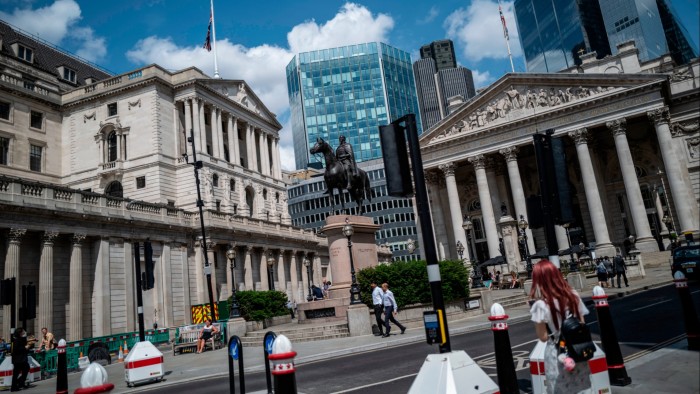Should the Bank of England adopt the Fed’s ‘dot plots’?

Roula Khalaf, Editor of the FT, selects her favourite stories in this weekly newsletter.
Central banking is as much an art as it is a science. It involves not only making economic judgments but also communicating them effectively — a job that the big central banks have struggled to get right in recent years. In an admission of its own imperfect record, the Bank of England last week announced a review into its performance.
The OECD forecasts UK inflation to be the highest in the G7 this year. A recent run of higher-than-expected wage and inflation data has raised concerns that price growth will remain sticky, while a BoE survey showed public satisfaction in the institution at an all-time low in May.
Like all central banks, the BoE needs to grapple with how it can improve its forecasting processes. Economic models are based on historical relationships, and their predictive capacity weakens when unexpected events like the coronavirus pandemic and war in Ukraine strike. Indeed, many central banks were too slow to raise rates before inflation hit 40-year highs last year.
Ultimately, any model would struggle in times of high uncertainty. This means improvements in how central banks convey their forecasts are essential. Here the BoE’s review can make strides.
Transparency is vital. How a central bank communicates its forecast and interest rate decisions influences future rate and inflation expectations — which has a real impact on household, business and investor decisions. So, if markets trust and understand the central bank’s forecasts, the effectiveness of monetary policy improves.
Guiding the markets has, however, been challenging for the BoE, particularly over this rate-raising cycle. “Consistently . . . it has suggested that interest rates wouldn’t need to rise as far as the markets expect,” said Paul Dales, chief UK economist at Capital Economics. “But it has then raised rates further than the markets expected.”
Improving its inflation forecast would clearly help. The review should look at why the BoE has consistently underestimated the persistence of inflation and tightness in labour markets, which has raised price pressures. But the circuitous way the BoE presents its projections makes things worse.
Its inflation forecasts are based on the markets’ own expectations for bank rate. Gertjan Vlieghe, a BoE external Monetary Policy Committee member between 2015 and 2021, reflected the flaws of this approach in a 2019 speech: “We communicate about what we think we may do, by showing you a forecast of what will happen if we do something else.” That is rather confusing.
One option for the BoE is to highlight its inflation forecasts based on interest rates staying at their current level. That helps give markets a sense of the inflation challenge the BoE thinks it is facing. This is useful since the MPC’s fan charts — which display a range of projected outcomes — also have a tendency to show inflation will eventually return close to its 2 per cent target over its forecast horizon. This confuses the market about where rates then need to go.
Another option, as Vlieghe advocated, is to show forecasts using the MPC’s preferred path for interest rates at yearly horizons — which would be published too. The US Federal Reserve, Reserve Bank of New Zealand and Norges Bank are among those that do something like this. Being more explicit about its likely rate path would help everyone better assess the BoE’s potential actions.
There is also a procedural benefit to this approach. The high potential for disagreement on a preferred rate path among MPC members could drive a more robust debate on the economic outlook. That is particularly useful in a time of uncertainty, when channelling diverse views, over herd thinking, takes on greater significance.
The BoE could also adopt something similar to the Fed’s “dot plot”. The policy-setting Federal Open Market Committee anonymously publishes members’ aggregated economic forecasts and their yearly preferred rate path.
The requirement to produce individual projections could drive a tougher committee debate, as members take greater ownership of their forecasts. Yet, the additional information can, and has at times, stoked more confusion. Berenberg, a bank, suggests a switch to central forecasts based on no rate change alongside Fed-style “dot plots” could be the best combination for the BoE.
Whatever the approach, at the very least, the BoE’s forecasts should tell us how it expects the economy to evolve and the rate path needed to achieve its target. Right now, it does both in a roundabout fashion. Changing that will not solve all its problems, but if it can help the public better understand what it thinks it needs to do to meet its objective, that will make its job at least a bit easier.
tej.parikh@ft.com
Comments